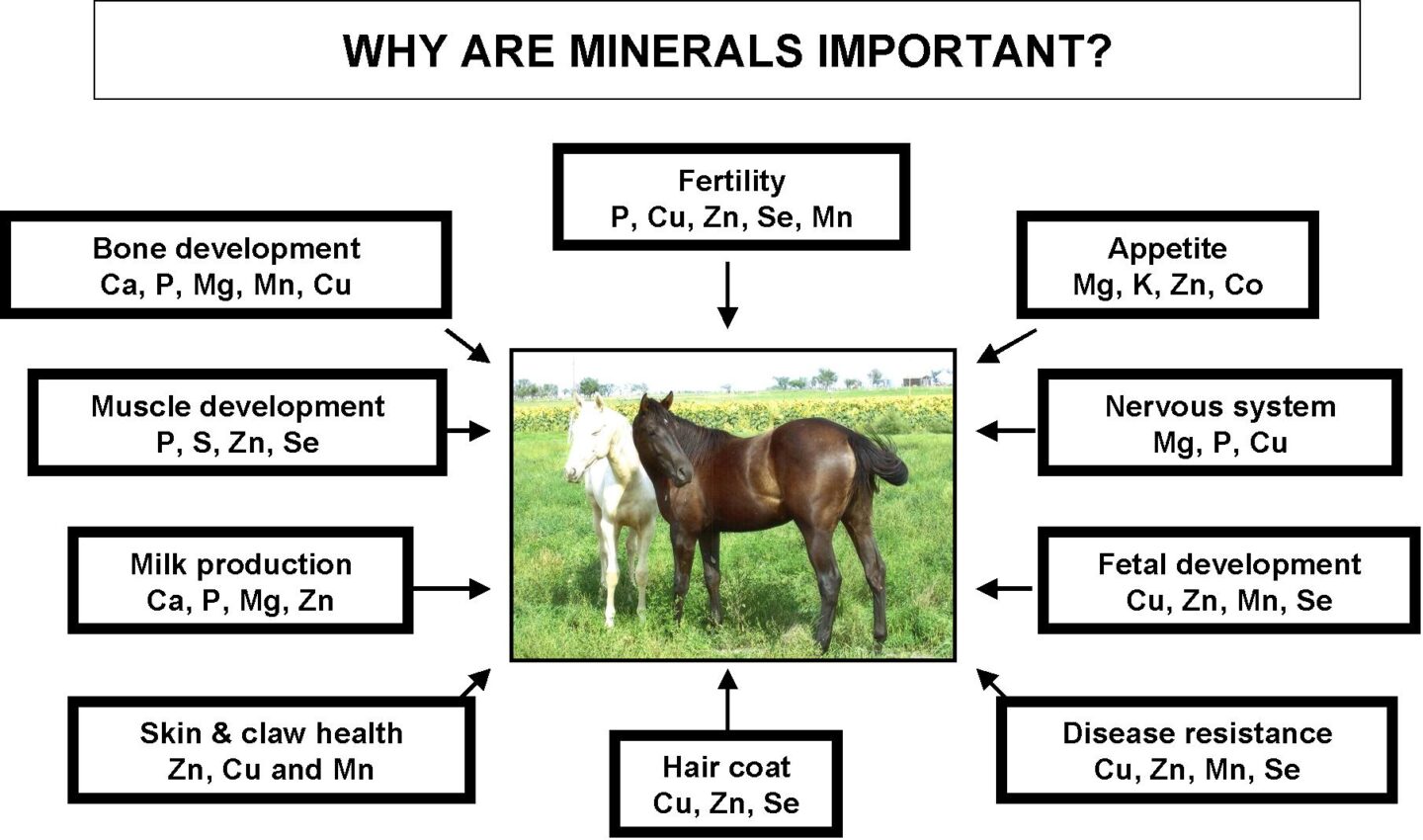Minerals in Horse Feeds

There are a variety of minerals that are important in horse nutrition. As we learned in previous blog posts, it is important not to put too great of an emphasis on any one particular mineral, although some do require greater supplementation than others. For example, rarely will iron or iodine be seen listed in the guaranteed analysis on a horse feed tag, but most all commercially prepared feeds will have guaranteed levels of copper and zinc. The reason for this is that some nutrients are naturally present in most forages, but others are often not present in high enough levels to fulfill the needs of today’s horse – a horse with the demands of performance placed on it.
Also, it is important to note that when looking at a feed tag, just because a particular mineral is not listed on the guaranteed analysis, that does not mean that it is not present in the feed. Many minerals are naturally occurring in the ingredients used to produce the feed, and in some cases does not need to be supplemented on top of the other ingredients.
Below is a quick guide to some of the basic minerals and what their function is in the horse:
Magnesium is necessary to reduce stress and irritability. Although rare, deficiency may occur in horses on high grain diets or animals in high-stress situations. If deficient, horses are high-strung, and jumpy. Rations with significant forage generally have no problem with magnesium deficiency. Grass tetany as seen in cattle is not an issue in horses, as horses absorb magnesium much more efficiently than cattle do. Toxicities are not generally seen in horses.
Potassium has a major function in muscle activity, and acid-base balance. It may be deficient in horses on high-grain diets. Deficiency symptoms may be reduced intakes, muscle weakness, diarrhea, and a slow-down in growth. Forage is important to prevent potassium deficiency. Toxicity is not generally an issue if adequate water is provided, as excesses are excreted in the urine.
- Potassium has gained most of its notoriety with the onset of HYPP in the quarter horse world. Feeding elevated levels of potassium can induce an attack in an HYPP-positive horse. Total dietary potassium in a HYPP-positive horse should be kept to less than 1%.
Cobalt is necessary for synthesis of vitamin B12 in the intestinal tract. However, the requirement is very low.
Copper is necessary for hemoglobin formation, along with iron and vitamin B12. Anemia and abnormal bone development in foals may be symptoms of deficiency. Often deficiencies occur in suckling foals, as the mare’s milk has very low levels of copper. Care should be taken with pregnant mares to feed a diet sufficient in copper during the last 3-4 months of gestation, when the unborn foal is laying down stores of copper in it’s liver to get through the nursing period without problems. Copper levels are also of great interest in developmental orthopedic diseases. Toxicity is very rare in horses, and deficiencies in mature horses are also not seen often.
Iodine is needed to make thyroxin, which controls the ratio of body metabolism. When iodine is deficient, foals may be born dead. Mares may be unable to nurse or have higher than normal naval ill when iodine is deficient. Both toxicity and deficiency lead to hyperthyroidism, due to the fact that a toxicity impairs/inhibits release of thyroid hormones, while a deficiency doesn’t allow for sufficient hormone production.
Iron is necessary for the formation of hemoglobin, which enables the blood to carry oxygen. Iron deficiency anemia is a deficiency symptom. Horses under the heavy stress of racing or showing may develop deficiency symptoms, as well as horses with chronic blood loss from parasite damage. Symptoms of toxicity can include depression, diarrhea, or increased susceptibility to bacterial infections.
Manganese is essential for bone formation, growth and reproduction. Manganese deficiency symptoms may be poor growth, lameness or bowing of legs, as well as reproductive dysfunction. Most feedstuffs are rich in manganese.
Selenium is associated with white muscle disease and the death of foals. Deficient animals have muscle disorders, such as tying-up. However, greater than 5 ppm selenium in the ration may be toxic to the horse. Feed companies are not allowed to supplement selenium at a rate that would give more than 0.3 ppm in the total daily intake when fed as directed. Should be fed with Vitamin E, as they work together in the body.
Zinc gives gloss or “bloom” to hair coat and is needed for protein synthesis and metabolism. Needs to be kept in ratio with copper, with the ideal ratio being between 1:3 and 1:4 copper to zinc. Zinc is also being heavily looked at in relation to the occurrence of developmental orthopedic diseases.
